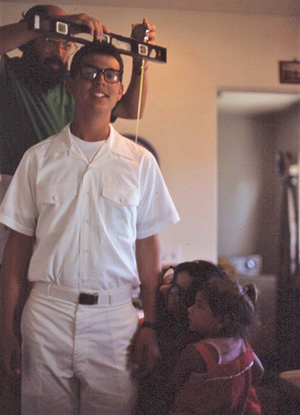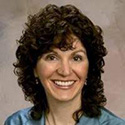‘I saved somebody’s life and it didn’t hurt me,’ says donor during National Multiethnic Donor Awareness Month

In 1992, Denise and Mushroom Montoya received the call no parent ever wants to get. Their 22-year-old son Jeremy had been in a terrible motorcycle accident. The hospital called to let them know and ask permission to treat him.

Mushroom Montoya measures his son Jeremy, just back from boot camp.
Within the week, Jeremy had been declared brain dead. Even though it was one of the worst experiences they could go through, Jeremy’s parents knew what to do. They agreed to donate Jeremy’s organs and tissues to others in need. They knew what to do because the family had discussed the topic of organ donation many times and Jeremy, a U.S. Navy Corpsman reservist, had declared that he was an organ donor on his driver’s license.
Jeremy’s heart went to a 52-year-old man named Robert in Albuquerque, who lived long enough to meet his birth mother, who had relinquished him for adoption. Jeremy’s kidneys went to two women in the Four Corners area of Utah, Colorado, Arizona, and New Mexico; his liver went to a grandmother in San Francisco. The transplants that occurred after Jeremy’s donation saved and/or improved the quality of life for more than 120 individuals who received either organs, bones, ligaments, skin, or other lifesaving tissues.
“I heard so many friends say, `I wish my child could have been a donor,’” Denise Montoya said. “Our son’s experience was a silver lining on an awful experience.”
Over the years, the couple has met some of the recipients. For many years, Mushroom would visit Robert in Albuquerque. It took him some time to work up the courage to ask Robert if he could listen to Jeremy’s heart. He eventually asked and Robert said yes.
“I put my head on his heart and I listened. I cried. We had a nice conversation. As I was leaving, he said, ‘you could listen one more time.’ I put my head to his chest. I was crying and he was crying. He said he’d never felt love like that before,” Mushroom recalls.
For the past 30 years, the Montoyas have dedicated themselves to raising awareness about kidney donation for Northwest Kidney Centers, the Seattle-based nonprofit that provides dialysis treatments to patients, many of whom eventually receive organ and tissue donations. Because Jeremy came from a mixed-race background—Mushroom is Hispanic and Native American—the couple has focused a significant amount of their time educating non-White communities about organ donation.
August is National Multiethnic Donor Awareness Month, a collaborative initiative of the National Multicultural Action Group to save and improve the quality of life of diverse communities by creating a positive culture for organ, eye, and tissue donation. The effort is focused primarily on African American, Hispanic, Asian/Pacific Islander and Native American communities.
According to the U.S. Department of Health and Human Services Office of Minority Health, non-White populations receive and donate far fewer organs than the White population. For example:
- While the number of transplants performed on Whites in 2020 was 48.8 percent of the number currently waiting, the number of organ transplants performed on Hispanics in 2020 was about 30 percent of the number of Hispanics awaiting a transplant. While 20.5 percent of the total candidates waiting for transplants are Hispanic, they comprised 14.6 percent of organ donors in 2020.
- The number of organ transplants performed on Blacks in 2020 was 27.7 percent of the number of Blacks awaiting a transplant. While 28.5 percent of the total candidates awaiting transplants are Black, they comprised 12.9 percent of organ donors in 2020.
- The number of organ transplants performed on American Indians/Alaska Natives in 2020 was 30 percent of the number of American Indians/Alaska Natives awaiting a transplant. While about 0.8 percent of the total candidates awaiting transplants are American Indian/Alaska Natives, they comprised 0.6 percent of organ donors in 2020.
- The number of organ transplants performed on Native Hawaiians/Pacific Islanders in 2020 was about 25 percent of the number of Native Hawaiians/Pacific Islanders awaiting a transplant. While 0.6 percent of the total candidates awaiting transplants are Native Hawaiians/Pacific Islanders, they comprised 0.3 percent of organ donors in 2020.
- The number of organ transplants performed on Asian Americans in 2020 was 24.7 percent of the number of Asians awaiting a transplant. While 8.5 percent of the total candidates awaiting transplants are Asian, they comprised 3.1 percent of organ donors in 2020.
While many organ donations come from deceased donors, a significant number—especially kidney donations—come from living donors. In 2010, George Taniwaki, who is of Japanese descent, decided to donate one of his kidneys. He read about kidney donation in a magazine and decided it was something he wanted to do. He became one of only about 160 people in the United States that year to donate anonymously as an “altruistic donor,” someone who chooses to donate to no one in particular, rather than to a friend or family member.
Taniwaki underwent a series of mental and physical tests to make sure he was healthy enough to donate—and that he wasn’t being coerced and wasn’t expecting his life to change dramatically or to get anything in return for his donation. Although his wife wasn’t happy with his decision initially, Taniwaki has no regrets. “I encourage people—if they know anyone who has kidney disease—to talk to them and consider donating to them. If they’re not compatible, donate through a chain,” he said, explaining that sometimes one altruistic donor can start a donation chain that involves many other donors.
Looking back, Taniwaki believes his donation was one of the highlights of his life. “It impacted my feeling of self-worth,” he said. “I felt like I did something that was important. I saved somebody’s life and it didn’t hurt me.”
Taniwaki has also served as a resource for other kidney donors and recipients, talking them through the process and addressing their expectations. He encourages all people who need kidney donations to reach out to family and friends and let their requests be known. “Sometimes it’s difficult for patients themselves to ask for a kidney,” he said. “The best way to go about it is to have someone act as your advocate. Someone who is ineligible to be the donor can ask others. Say ‘I can’t do it, but can you?’”
There are many reasons non-White communities are under-represented as organ donors and recipients. Often, communities mistrust the healthcare system, based on years of discrimination and unethical care. Some cultures feel guilty asking for such a big gift or worry that, by wishing for a donor for themselves or a loved one, they are also wishing harm to another person who must die in order for a donation to come through. Donating an organ also involves surgery and recovery, something that could be difficult for individuals who don’t have health insurance and must take time off work.
LifeCenter Northwest, a local nonprofit organ procurement and tissue recovery organization, is working to reach out to non-White communities. They use census data, translate marketing materials into multiple languages, and create social media posts to share organ donation and recipient stories from diverse voices. They partner with local cultural and ethnic groups to learn from and speak to their members.
“Historically, minority communities have been left out of the loop,” said Jenna Pringle, LifeCenter Northwest’s senior communications specialist. “Multicultural communities tend to be more vulnerable and less trusting of medical providers. A lot of myths still exist about organ donation, especially how to become one, and criteria that’s required.”
Pringle notes that she has heard from people who worry whether emergency responders will work to save their lives if they are organ donors. “Emergency responders and hospital staff do not have access to the donor registry and their only objective is to save your life,” Pringle said. “Organ donation is only possible after all life-saving methods have been tried and failed.”
Pringle especially appreciates the work that the Montoyas and Taniwaki are doing to educate others in their own communities about organ donation. “Whenever possible, we would love for transplant recipients to talk to other people of color about their experiences to encourage more people to register as donors or consider receiving a transplant,” she said.
 Contributor Cynthia Flash owns Flash Media Services, a media consulting firm based in Bellevue. Northwest Kidney Centers is her client. Reach her at cynthia@flashmediaservices.com.
Contributor Cynthia Flash owns Flash Media Services, a media consulting firm based in Bellevue. Northwest Kidney Centers is her client. Reach her at cynthia@flashmediaservices.com.
For more information about organ and tissue donation, and responses to some of the myths related to donation, visit Understanding Donation (LifeCenter Northwest).
![AgeWise King County [logo]](https://www.agewisekingcounty.org/wp-content/themes/agewisekingcounty/images/logo.png)